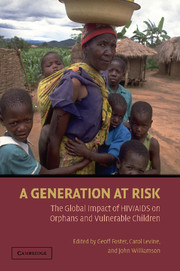Book contents
- Frontmatter
- Contents
- Foreword
- Preface
- Contributors
- Introduction: HIV/AIDS and Its Long-Term Impact on Children
- 1 Family and Community-Based Care for Children Affected by HIV/AIDS: Strengthening the Front Line Response
- 2 Strengthening Households and Communities: The Key to Reducing the Economic Impacts of HIV/AIDS on Children and Families
- 3 The Response of the Educational System to the Needs of Orphans and Children Affected by HIV/AIDS
- 4 Psychosocial Impact of the HIV/AIDS Epidemic on Children and Youth
- 5 Human Rights and Children Affected by HIV/AIDS
- 6 Religion and Responses to Orphans in Africa
- 7 Making the Right Choices in the Asia-Pacific Region: Protecting Children and Young People from HIV and Its Impacts
- 8 Troubled Tapestries: Children, Families, and the HIV/AIDS Epidemic in the United States
- 9 Interventions to Support Children Affected by HIV/AIDS: Priority Areas for Future Research
- 10 Finding a Way Forward: Reducing the Impacts of HIV/AIDS on Vulnerable Children and Families
- Chronology of Important Events
- Resource Guide
- Index
- References
8 - Troubled Tapestries: Children, Families, and the HIV/AIDS Epidemic in the United States
Published online by Cambridge University Press: 05 June 2012
- Frontmatter
- Contents
- Foreword
- Preface
- Contributors
- Introduction: HIV/AIDS and Its Long-Term Impact on Children
- 1 Family and Community-Based Care for Children Affected by HIV/AIDS: Strengthening the Front Line Response
- 2 Strengthening Households and Communities: The Key to Reducing the Economic Impacts of HIV/AIDS on Children and Families
- 3 The Response of the Educational System to the Needs of Orphans and Children Affected by HIV/AIDS
- 4 Psychosocial Impact of the HIV/AIDS Epidemic on Children and Youth
- 5 Human Rights and Children Affected by HIV/AIDS
- 6 Religion and Responses to Orphans in Africa
- 7 Making the Right Choices in the Asia-Pacific Region: Protecting Children and Young People from HIV and Its Impacts
- 8 Troubled Tapestries: Children, Families, and the HIV/AIDS Epidemic in the United States
- 9 Interventions to Support Children Affected by HIV/AIDS: Priority Areas for Future Research
- 10 Finding a Way Forward: Reducing the Impacts of HIV/AIDS on Vulnerable Children and Families
- Chronology of Important Events
- Resource Guide
- Index
- References
Summary
The HIV/AIDS epidemic in the United States humbles those who try to ameliorate its impact on children and families. Certainly, more resources are available than in Africa or Asia and the scale of the epidemic is much less daunting, but the problems of affected families and communities are so entrenched and unyielding that efforts to address the problems directly related to the disease reach only the most visible aspect of troubled families' lives. Despite the differences in culture, resources, and experience with disease between the United States and other areas affected by the global epidemic, at the most basic human level there are also strong similarities. Parents grieve the deaths of children; grandmothers take on the care of their grandchildren; children's lives are irrevocably altered by a parent's death. There is much in common and much to learn from each other, even as we pursue different strategies to treat the wounds.
In this chapter we present a brief review of the HIV/AIDS epidemic in the United States and New York City and the response of The Family Center to the epidemic. We focus on some of the issues relating to children and families that have been the hardest to address and resolve, and conclude by suggesting some practices that reflect what The Family Center has learned over the past ten years.
- Type
- Chapter
- Information
- A Generation at RiskThe Global Impact of HIV/AIDS on Orphans and Vulnerable Children, pp. 213 - 231Publisher: Cambridge University PressPrint publication year: 2005
References
- 2
- Cited by



